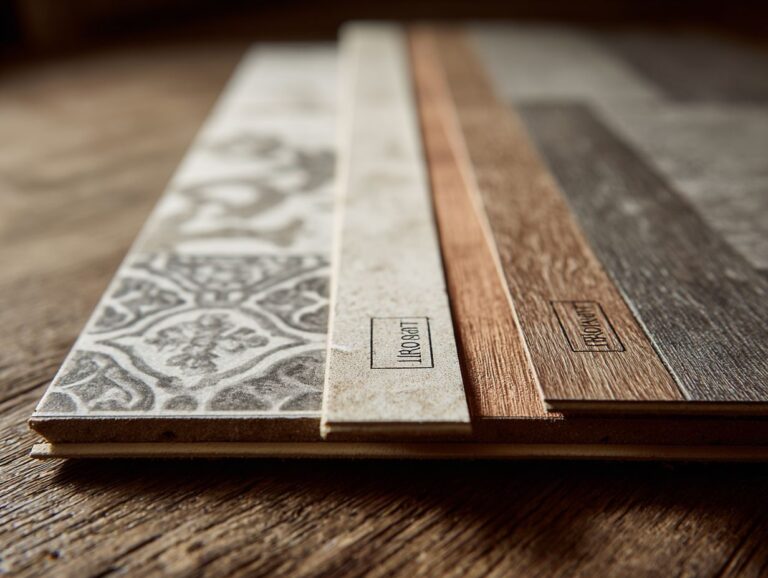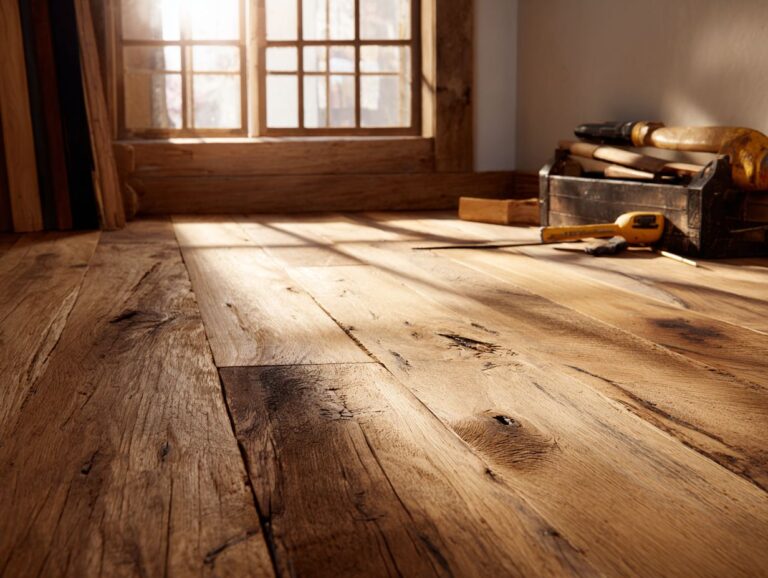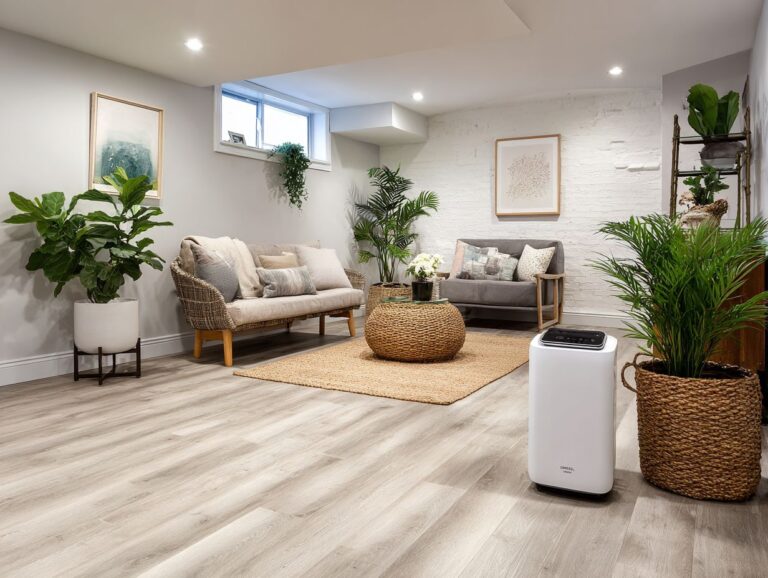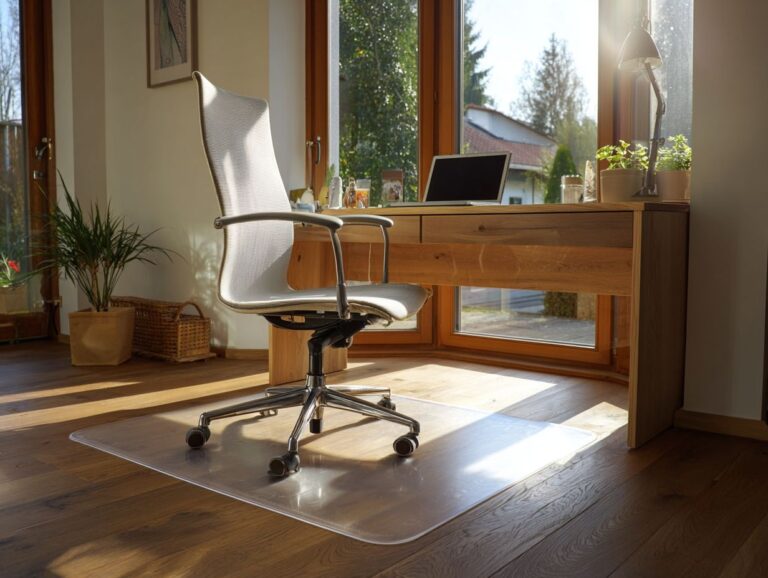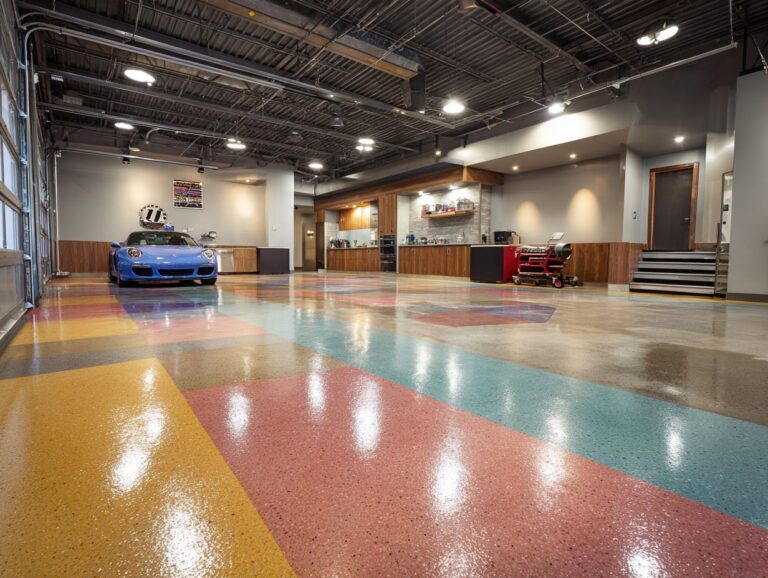Vinyl Flooring Wear Layer – Thickness and Durability Guide
When picking vinyl flooring, the wear layer is important for durability and keeping it looking nice for a long time. In this guide, flooring specialist David Brannan looks into how the thickness of Luxury Vinyl Plank (LVP) and Wood Plastic Composite (WPC) affects how well your flooring works. Learn how to choose the best thickness for your space and daily life, ensuring you enjoy vinyl flooring for a long time.
Key Takeaways:
Contents
- Understanding Wear Layer Thickness
- Durability of Vinyl Flooring
- Vinyl Flooring Durability Statistics
- Choosing the Right Thickness
- Maintenance and Care
- Common Myths about Vinyl Flooring
- Additional Resources
- Frequently Asked Questions
- What is a vinyl flooring wear layer?
- How does the thickness of the wear layer affect the durability of vinyl flooring?
- What is the recommended thickness for a vinyl flooring wear layer?
- How does the durability of a vinyl flooring wear layer compare to other types of flooring?
- Can the wear layer be replaced if it gets damaged?
- What are some factors to consider when choosing the thickness of a vinyl flooring wear layer?
What is Vinyl Flooring?
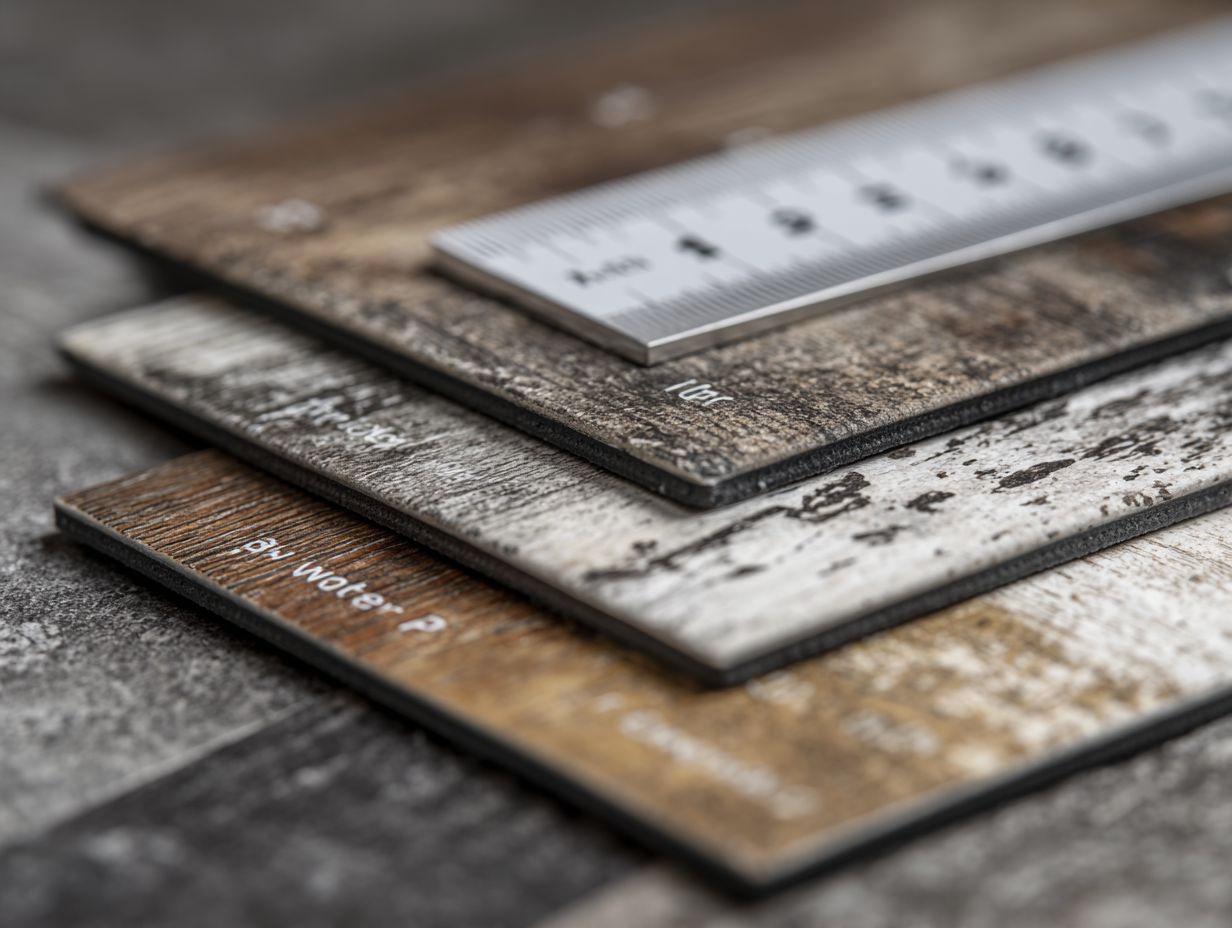
Vinyl flooring is a synthetic product made primarily from PVC, available in two major types: Wood Plastic Composite (WPC) and Stone Plastic Composite (SPC).
WPC flooring has a core made from wood fibers and PVC, giving it extra warmth and comfort, which is perfect for homes.
Brands like Shaw’s Modeled Oak provide many color and texture options, attracting homeowners who want wood-like appearances.
In contrast, SPC flooring contains a denser core primarily made from limestone, resulting in greater durability and water resistance, perfect for high-traffic areas.
Brands like Happy Feet’s European Oak demonstrate durability and visual charm, fitting well for homes and businesses.
Importance of the Wear Layer
The wear layer of vinyl flooring, usually between 0.3 mm and 0.7 mm, is important because it affects how long the flooring lasts and how well it holds up over time.
A thicker wear layer, like 0.5 mm or more, is perfect for areas with a lot of foot traffic, such as businesses or busy homes, because it offers better protection against scratches and stains.
For instance, residential spaces may function well with a 0.3 mm layer, while a 0.7 mm layer is recommended for environments like restaurants or retail shops.
Consider using tools like a flooring calculator to assess the best wear layer thickness based on your specific usage and traffic conditions for effective protection.
Understanding Wear Layer Thickness
Knowing how thick the wear layer is helps you choose the right vinyl flooring, as it greatly affects how well it lasts and works. For those deciding between product types, understanding the differences in durability and application is essential (explore our Luxury Vinyl Plank vs. Luxury Vinyl Tile guide for further insights).
Definition of Wear Layer Thickness
Wear layer thickness is defined as the top protective layer of vinyl flooring, measured in mils (thousandths of an inch) or millimeters, which determines its ability to withstand wear and tear.
A thickness of 20 mils or more is generally suggested for commercial use, offering strong durability against heavy foot traffic.
For residential use, a 12-20 mil wear layer is generally adequate, ensuring both longevity and aesthetic appeal.
To measure wear layer thickness, manufacturers often specify it on packaging or product descriptions. Choosing the right thickness is important because a thicker wear layer helps prevent scratches and stains, which makes the flooring last longer and keeps it looking good over time.
Common Thickness Options
Common wear layer thickness options for vinyl flooring typically range from 6 mil to 20 mil, affecting the product lifespan and suitability for high-traffic areas.
A 6 mil layer works well for homes with minimal use, while a 12 mil layer can withstand more activity, making it ideal for living rooms and kitchens.
For commercial spaces, opting for a 20 mil layer is essential, as it offers superior durability and resistance to scratches. Brands like Shaw and Armstrong offer different thickness options for various settings.
When choosing, assess the expected foot traffic and select a thickness that aligns with your lifestyle and maintenance preferences.
How Thickness Affects Performance
The thickness of the wear layer affects how long the product lasts and improves soundproofing and foot comfort, which are important for user satisfaction.
For example, a thicker wear layer, typically over 20 mil, can significantly reduce noise, making it ideal for buildings with several floors or office environments. Conversely, a thinner layer, around 6-12 mil, may be more budget-friendly but could compromise durability and acoustic performance.
Using tools like the 3M acoustic underlayment can improve soundproofing when combined with thicker flooring. Evaluating your environment and foot traffic patterns will help determine the right thickness, ensuring both comfort and longevity in your flooring choice.
Durability of Vinyl Flooring
The long-lasting nature of vinyl flooring makes it popular, affected by things like the thickness of the protective layer and how well the product is made. For those considering their options, understanding the differences in durability between Luxury Vinyl Plank (LVP) and Luxury Vinyl Tile (LVT) can be valuable.
Vinyl Flooring Durability Statistics
Vinyl Flooring Durability Statistics
Lifespan Comparison: Average Lifespan
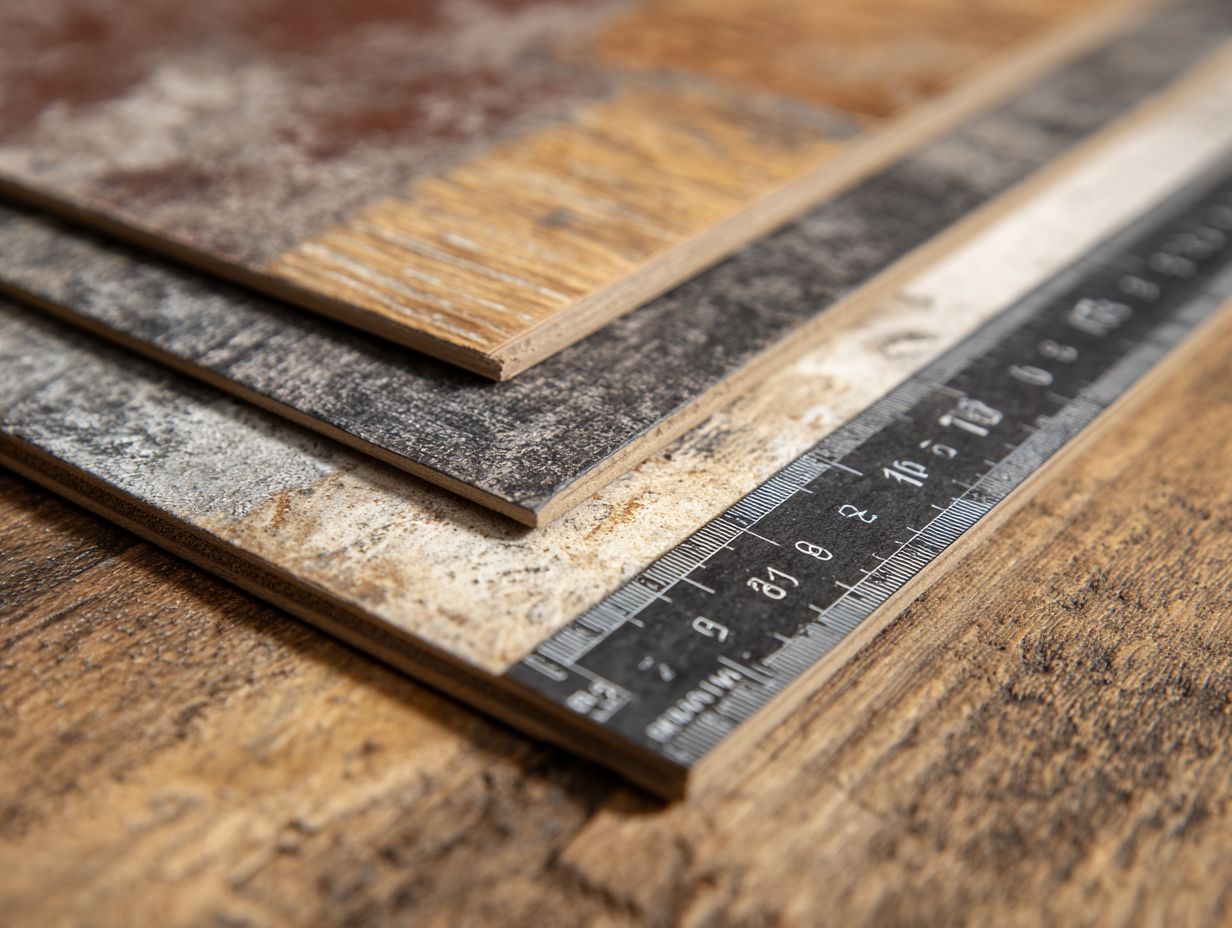
Strength Considerations: Ways to Make Things Last Longer
The Vinyl Flooring Durability Statistics give details about how long different types of vinyl flooring last and how well they hold up, important for people who want to choose wisely when buying flooring. Knowing these measurements helps choose the right flooring for how it will be used and how much foot traffic it will get.
Lifespan Comparison reveals that Sheet Vinyl Flooring typically lasts around 15 years This makes it an affordable option for places that do not require heavy use. Luxury Vinyl Plank (LVP) offers a longer lifespan of up to 20 years, appealing to those who desire a more durable option with an aesthetic resembling natural wood. The most durable option, Luxury Vinyl Tile (LVT), can last up to 25 years, providing superior longevity and resistance to wear, which is ideal for high-traffic areas or commercial spaces.
The Durability Factors section highlights the importance of the wear layer thickness, which significantly impacts the flooring’s endurance. For residential use, a wear layer thickness of 12 mil is recommended. This thickness provides enough protection against daily damage in homes, making sure the flooring lasts as long as expected. For high traffic areas, such as commercial environments or busy homes, a thicker wear layer of 20 mil is advisable. The added thickness makes it more durable, protecting it from more people walking on it and possible damage from frequent use.
These numbers explain why picking the right vinyl flooring is important and why you should pay attention to the thickness of the wear layer to ensure it is durable. By factoring in lifespan expectations and traffic levels, consumers can select a flooring solution that balances cost-effectiveness with performance, ensuring long-lasting satisfaction with their investment.
Factors Influencing Durability
Key factors influencing the durability of vinyl flooring include wear layer thickness, material composition (WPC vs. SPC), and maintenance routines.
The thickness of the wear layer affects how long the flooring lasts; for instance, Flooret provides a wear layer of 20 mils, which is suitable for places with heavy use, such as commercial areas.
On the other hand, Modin Craftsman uses a sturdy SPC core, which makes it more resistant to impacts and moisture. Regular upkeep is important; using a cleaner with balanced pH stops buildup and makes it last longer.
To choose the right product, evaluate your specific needs-if you’re looking for long-term performance in busy settings, consider thicker layers and sturdy material compositions.
Comparing Durability Across Brands
Comparing the durability of popular vinyl flooring brands reveals significant differences based on their material composition and wear layer thickness.
Brands like Shaw and Happy Feet each offer unique benefits that cater to specific needs.
Shaw boasts a wear layer thickness of 20 mils, providing strong resistance against scratches and dents, backed by a lifetime residential warranty. Happy Feet has a 12 mil wear layer and includes a 30-year warranty, which makes it suitable for residential use with less foot traffic.
Both brands excel in impact insulation, but Shaw generally achieves a higher rating due to its advanced construction. Homeowners should choose based on desired durability and the specific conditions of their living spaces.
Choosing the Right Thickness
Choosing the right thickness for vinyl flooring is important to make sure it works well in homes or businesses.
Residential vs. Commercial Use
When choosing vinyl flooring, it’s essential to consider whether it will be used in residential or commercial spaces, as this impacts recommended thickness.
For residential use, vinyl flooring typically ranges from 2mm to 5mm in thickness, providing sufficient durability for standard foot traffic.
In contrast, commercial spaces, which experience heavier foot traffic and potential wear, often require vinyl that is 6mm or thicker. Consider protective attributes like a wear layer; for example, a 20 mil wear layer is recommended for commercial environments to withstand scratches and stains.
It’s also wise to evaluate specific needs, such as moisture resistance in areas prone to spills, ensuring you choose a suitable option for your space.
Traffic Considerations
Traffic type-high vs. low-significantly affects the necessary thickness for vinyl flooring, with thicker options recommended for high-traffic areas.
For high-traffic zones like hallways or family rooms, opt for vinyl flooring with a thickness of 4mm or more, which offers better durability and resistance to wear.
Conversely, in low-traffic areas such as bedrooms or offices, a 2-3mm thickness can suffice while providing adequate comfort.
Consider brands like Shaw for thick options, and Armstrong for lighter alternatives. Make sure to check the wear layer thickness, and choose at least 20 mils for areas with frequent use to make it last longer.
Climate and Environmental Factors
Climate and environmental conditions, such as humidity and temperature fluctuations, can influence the performance and longevity of vinyl flooring.
In humid regions, for example, thicker vinyl flooring (around 5mm) is often recommended as it better resists expansion and contraction, enhancing durability. Conversely, in cooler climates, thinner vinyl (around 2-3mm) can suffice, as the temperature variations are less extreme.
You should check the state of the subfloor as well; a concrete subfloor in a wet area might need a layer to manage moisture. Always assess local weather patterns and select materials that balance aesthetics with functional resilience.
Maintenance and Care
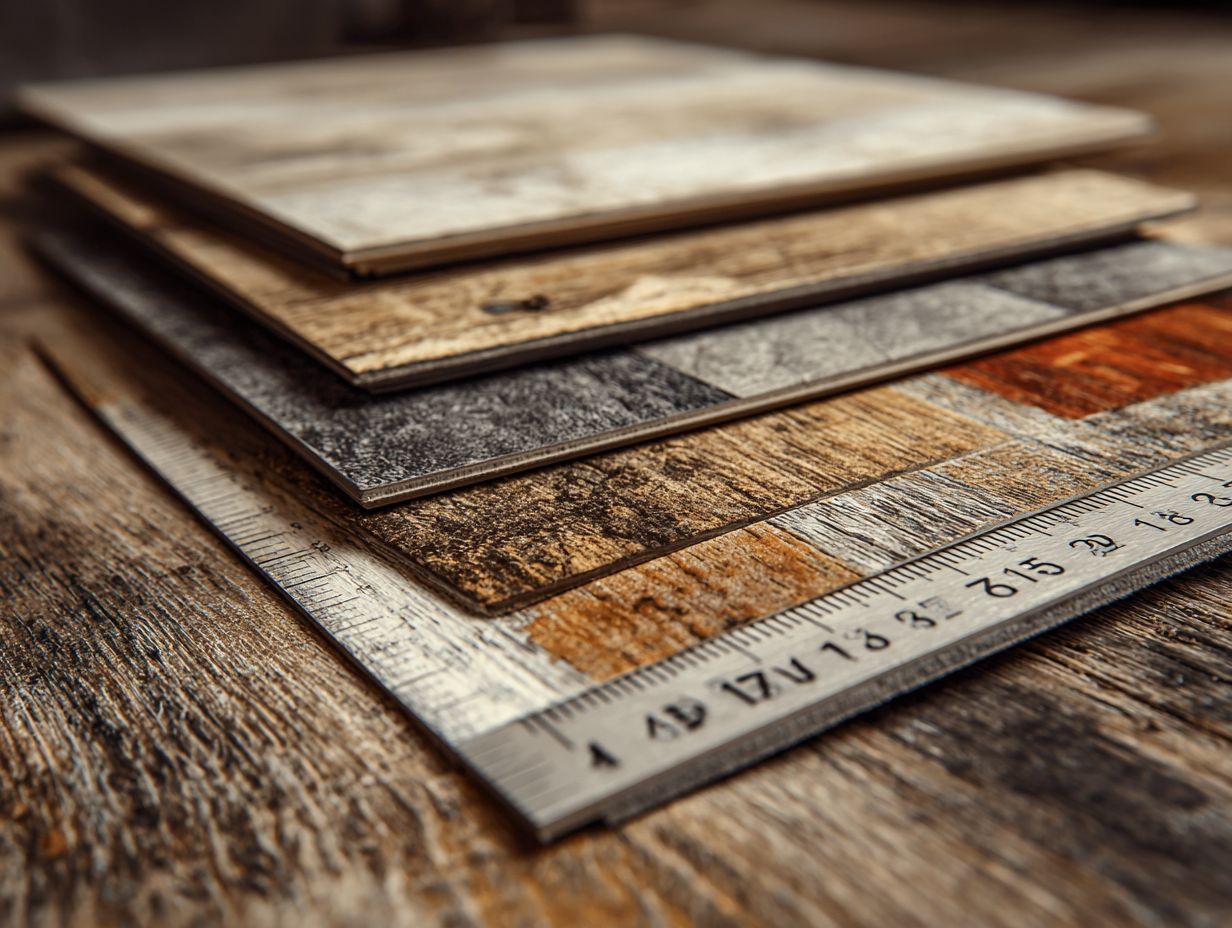
Regular upkeep and attention are important to keep vinyl flooring looking good and lasting a long time, in both homes and business spaces. If you’re interested in comparing different types of vinyl flooring, you might appreciate our Luxury Vinyl Plank (LVP) vs Luxury Vinyl Tile (LVT) Guide.
Cleaning Recommendations
To maintain vinyl flooring, regular cleaning with pH-balanced products and avoiding harsh chemicals can extend the product lifespan significantly.
Use a mild cleaner specifically designed for vinyl, such as a diluted solution of white vinegar and water. Clean high-traffic areas weekly and less frequented sections bi-weekly to prevent dirt buildup.
Consider using a soft-bristle broom or a vacuum cleaner without a beater bar to avoid scratching. For deeper cleans, employ a mop dampened with the vinegar solution monthly, ensuring no excess water is left behind.
Avoid petroleum-based cleaners, as these can damage the finish over time.
Preventative Measures
Implementing preventative measures, such as using mats and furniture pads, can significantly reduce wear and improve sound ratings for vinyl flooring.
Along with mats and pads, consider applying a few more strategies. Regularly sweeping or vacuuming helps remove dirt and grit that can scratch the surface.
Use a damp mop with a cleaner specifically designed for vinyl to maintain its sheen. Avoid placing heavy furniture directly on the floor; instead, use coasters or small furniture glides to distribute weight.
By following these steps, you can keep your floor looking good and make it last longer, making it a good choice for any home.
Common Myths about Vinyl Flooring
People often have wrong ideas about vinyl flooring that can affect how they view its quality and performance. It’s important to clear these up to help with buying choices.
Myth: Thicker is Always Better
The belief that thicker vinyl flooring is always superior can mislead consumers, as the right thickness depends on specific use cases and environments.
For example, thicker vinyl (8-12 mm) is ideal for high-traffic areas like retail spaces, where durability is key.
In residential settings, especially in bedrooms or dining areas, a thickness of 4-6 mm may suffice, providing comfort underfoot while being cost-effective.
Consider the layer underneath: a quality foam layer can make a room quieter and the surface softer, which makes thinner options attractive for home use.
In the end, considering how much the space is used, what the room will be used for, and personal comfort can help choose the best vinyl flooring.
Myth: Vinyl is Not Durable
Contrary to popular belief, high-quality vinyl flooring can provide exceptional durability and performance, rivaling more traditional flooring options like laminate.
In fact, products like luxury vinyl tile (LVT) and vinyl plank flooring are designed for high-traffic areas, featuring thick wear layers and waterproof properties.
For instance, brands like Shaw and Mannington offer options with wear layers exceeding 30 mil, ensuring resilience against scratches and stains. These floors can easily manage spills and a lot of foot traffic, so they work well in kitchens and hallways.
With proper maintenance such as regular sweeping and occasional mopping, vinyl can last 15 to 20 years, proving to be an excellent long-term investment.
Final Thoughts on Wear Layer Thickness
The thickness of the wear layer you select can greatly impact how your flooring will look and perform.
A thicker wear layer, usually between 20 to 30 mils, provides stronger durability for busy areas, while a 12 to 20 mil layer is suitable for homes.
For instance, luxury vinyl planks (LVP) with a 30 mil layer are ideal for commercial environments, providing resistance against scratches and dents. Customers often prefer brands like Shaw and Mohawk for stronger options.
Look at how often and how much use the area will get. Think about where you want to put the flooring and how long you want it to last before you decide.
Summary of Key Points
Important points from our talk include the importance of wear layer thickness, elements affecting how long it lasts, and the misconceptions that can affect views on vinyl flooring.
The wear layer serves as the primary shield against scratches and stains, typically ranging from 0.5mm to 5mm. For residential spaces, a thickness of 0.5mm to 1mm suffices, while commercial settings often benefit from 2mm or thicker layers.
Beyond thickness, consider factors like installation quality and humidity levels, which can affect lifespan. Common myths include the belief that all vinyl is the same, where differences in materials radically affect performance.
Knowing these details helps individuals make decisions that suit their needs.
Additional Resources
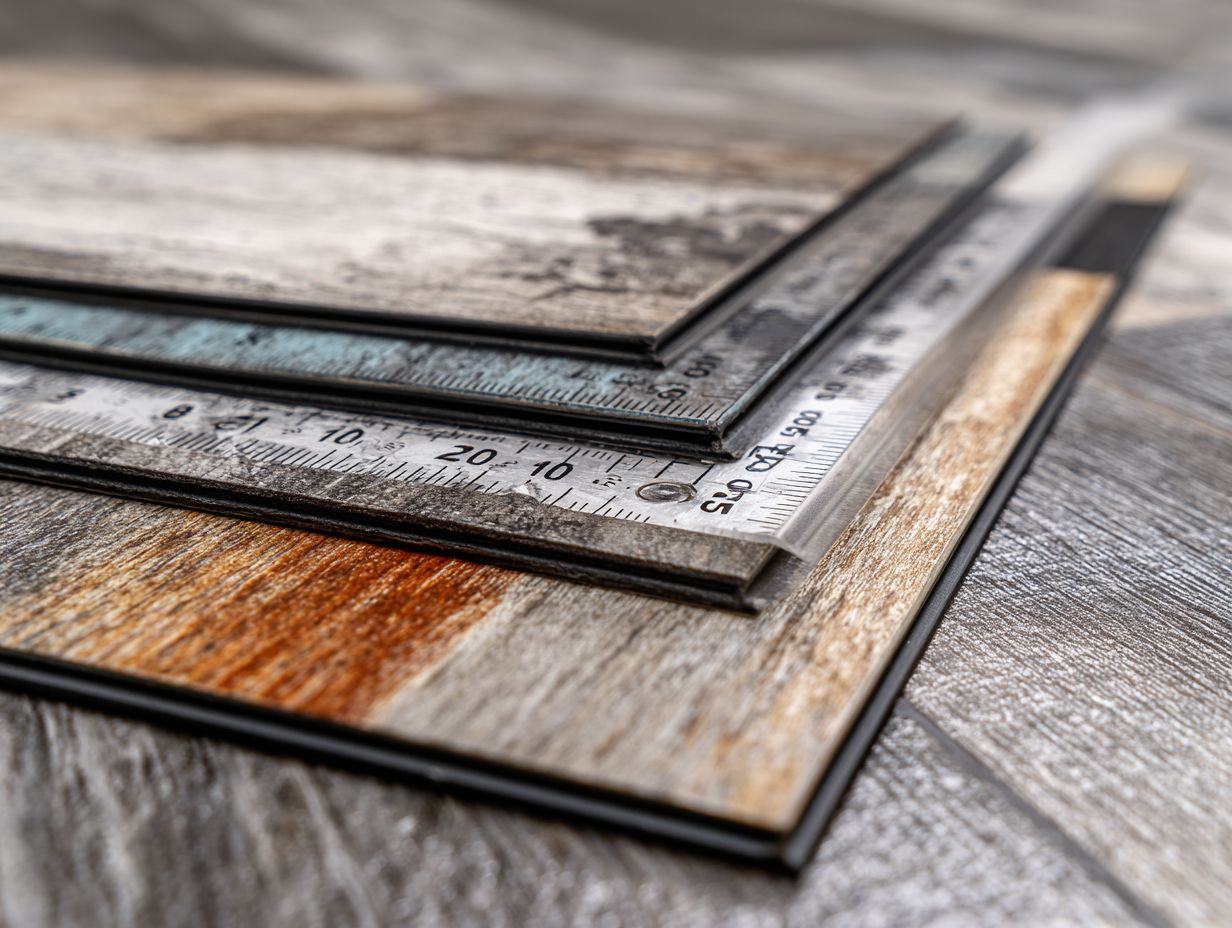
To help you learn more and buy the best vinyl flooring, here are some selected resources and stores that offer high-quality options.
Where to Buy Quality Vinyl Flooring
Quality vinyl flooring can be sourced from reputable retailers like Home Depot, Lowe’s, and specialized flooring sites, ensuring budget-friendly options are available.
Along with these retailers, consider online platforms like Wayfair and BuildDirect, which often provide competitive pricing and a wider selection.
Prices for vinyl flooring typically range from $1.50 to $5 per square foot, depending on quality and design.
Always look for certification labels, like FloorScore or Greenguard, to confirm you are picking materials without harmful chemicals.
Reading customer reviews can help identify the longevity and performance of specific products before purchasing.
Frequently Asked Questions
What is a vinyl flooring wear layer?
A vinyl flooring wear layer is a protective coating that is applied to the top surface of vinyl flooring. It is designed to protect the flooring from wear and tear, such as scratches, stains, and fading.
How does the thickness of the wear layer affect the durability of vinyl flooring?
The thickness of the wear layer directly impacts the durability of vinyl flooring. A thicker wear layer provides better protection against wear and tear and can extend the lifespan of the flooring.
What is the recommended thickness for a vinyl flooring wear layer?
The recommended thickness for a vinyl flooring wear layer is at least 20 mil. This thickness offers adequate protection for most residential and light commercial use.
How does the durability of a vinyl flooring wear layer compare to other types of flooring?
Vinyl flooring with a thick wear layer is highly durable and can withstand heavy foot traffic and daily wear and tear. It is often more durable than hardwood, laminate, and carpet flooring.
Can the wear layer be replaced if it gets damaged?
In most cases, the wear layer of vinyl flooring cannot be replaced. But some manufacturers provide vinyl flooring with a wear layer that can be taken off and swapped if it gets damaged.
What are some factors to consider when choosing the thickness of a vinyl flooring wear layer?
When choosing the thickness of a vinyl flooring wear layer, consider the level of foot traffic in the area, the type of flooring installation (glue-down vs. floating), and the type of room (residential vs. commercial). Thicker wear layers are recommended for high traffic areas and commercial settings.
